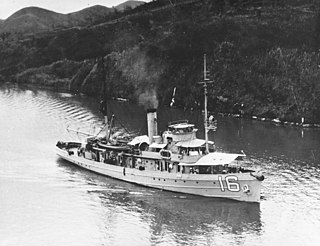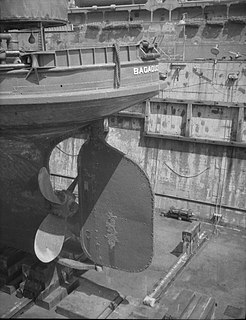The United States Navy, United States Coast Guard, and United States National Oceanic and Atmospheric Administration (NOAA) use a hull classification symbol to identify their ships by type and by individual ship within a type. The system is analogous to the pennant number system that the Royal Navy and other European and Commonwealth navies use.
USS Bobolink (AM-20/AT-131/ATO-131) was a Lapwing-class minesweeper acquired by the United States Navy for the dangerous task of removing mines from minefields laid in the water to prevent ships from passing.

USS Rail (AM-26/AT-139/ATO-139) was a Lapwing-class minesweeper built for the United States Navy during World War I. She was the first U.S. Navy ship named for the rail, a small wading bird, related to the cranes.

USS Lapwing (AM-1/AVP-1) was the lead ship of her class of minesweeper – the first minesweeper of the United States Navy. She was named after a bird, the lapwing, an abundant crested plover of Europe, Asia, and northern Africa, noted for its slow, irregular, flapping flight and its shrill wailing cry.

USS Lapwing was a YMS-1-class minesweeper of the YMS-135 subclass built for the United States Navy during World War II. She was named after the lapwing.

USS Owl (AM-2) was an Lapwing-class minesweeper acquired by the U.S. Navy for the dangerous task of removing mines from minefields laid in the water to prevent ships from passing.

USS Robin (AM-3) was an Lapwing-class minesweeper acquired by the U.S. Navy for the dangerous task of removing mines from minefields laid in the water to prevent ships from passing.

USS Oriole (AM-7) was a Lapwing-class minesweeper acquired by the U.S. Navy for the dangerous task of removing mines from minefields laid in the water to prevent ships from passing.

USS Woodcock (AM-14) was an Lapwing-class minesweeper acquired by the United States Navy for the dangerous task of removing mines from minefields laid in the water to prevent ships from passing.

USS Partridge (AM-16) was an Lapwing-class minesweeper acquired by the United States Navy for the dangerous task of removing mines from minefields laid in the water to prevent ships from passing.

USS Turkey (AM-13) was an Lapwing-class minesweeper the U.S. Navy, thus named after the bird, not after the country which in 1917 was an enemy in the ongoing World War I. The minesweeper was acquired by for the dangerous task of removing mines from minefields laid in the water to prevent ships from passing.

The first USS Lark (AM-21) was a Lapwing-class minesweeper in the United States Navy. She was named for the lark.

USS Seagull (AM-30) was an Lapwing-class minesweeper acquired by the United States Navy for the dangerous task of removing mines from minefields laid in the water to prevent ships from passing.

The second USS Tern (AM-31) was an Lapwing-class minesweeper acquired by the U.S. Navy for the dangerous task of removing mines from minefields laid in the water to prevent ships from passing.
USS Cormorant (AM-40) was an Lapwing-class minesweeper acquired by the United States Navy for the dangerous task of removing mines from minefields laid in the water to prevent ships from passing.

USS Gannet (AM-41) was an Lapwing-class minesweeper built for the United States Navy near the end of World War I.

USS Kingfisher (AM-25/AT-135/ATO-135) was an Lapwing-class minesweeper acquired by the U.S. Navy for the dangerous task of removing mines from minefields laid in the water to prevent ships from passing.

USS Whippoorwill (AM-35) was a Lapwing-class minesweeper of the United States Navy.

USS Vireo (AM-52) was a U.S. Navy Lapwing-class minesweeper, No. 52, reclassified on 1 June 1942 as a fleet tug. The bulk of her combat career was served in this capacity.

USS Bagaduce (AT-21/ATO-21) was the lead ship of the Bagaduce class of fleet tugs for the United States Navy. She was the first ship of the U.S. Navy of that name, and is named for the Bagaduce River and a peninsula in Hancock County, Maine.
















